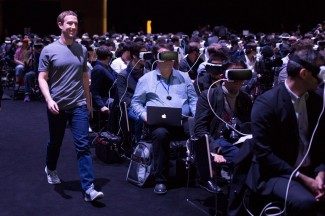A new video of Magic Leap’s augmented reality tech in action was shown at a conference in China today.
On stage at the event, Magic Leap CMO Brian Wallace had a one-on-one discussion with Alibaba CMO Chris Tung (Alibaba is one of Magic Leap’s major investors). Brian said that the company is working on an AR headset that’s portable, lightweight, and can be worn all day, and further said that the aim is to someday replace smartphones completely.
Part way through the discussion Wallace introduced a new video showing off the experience of Magic Leap’s mysterious augmented reality tech. A video of the full discussion was published by Tech.qq.

While prior Magic Leap videos have focused on entertainment and productivity use-cases, the new video’s concept involved a pregnant mother shopping for new items in her baby room. This is the first video from the company to show voice control as a method of input.
Using voice commands, the user in the video measures the available space and is then presented with several options which will fit. She’s able to preview the products such that they’re convincingly inserted into the real world. After trying out a cloud lamp and giraffe lamp, she opts to buy the latter, and we can see the lamp animate to confirm the purchase.
While Magic Leap’s video demonstrations are impressive, they’re also shrouded in mystery. The company hasn’t publicly shown the device that’s enabling these videos.
Prior Magic Leap videos, which the company says were filmed through their AR technology with no special effects, show a robot and a solar system in an office, an augmented reality workstation interface, and life-sized Star Wars characters.







